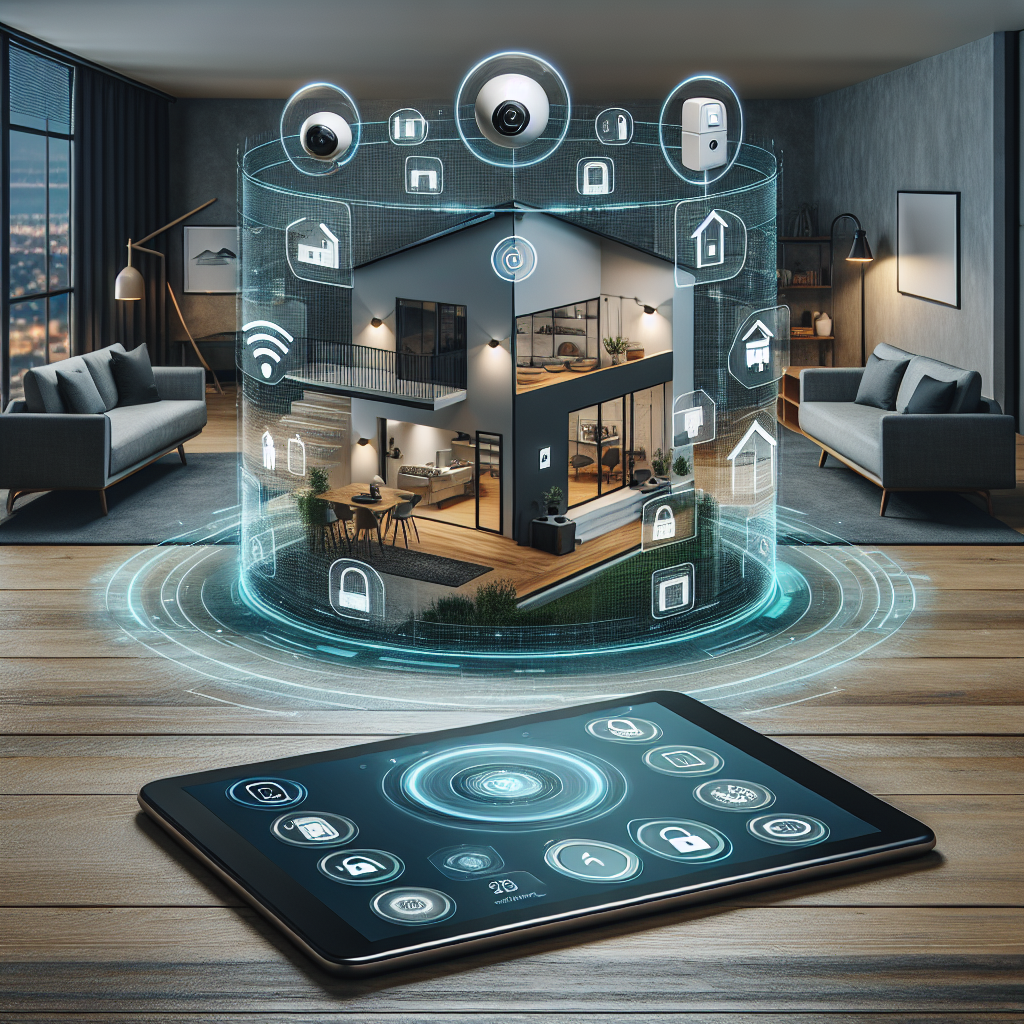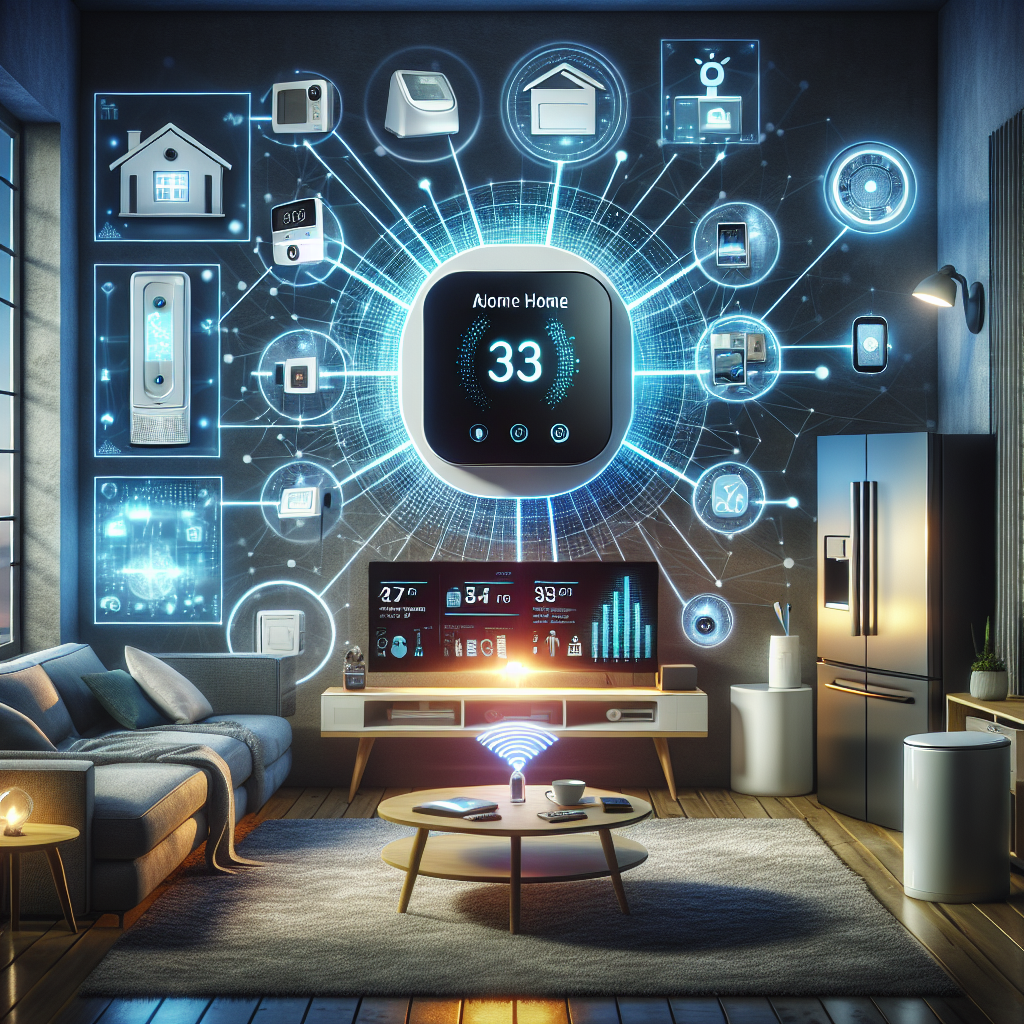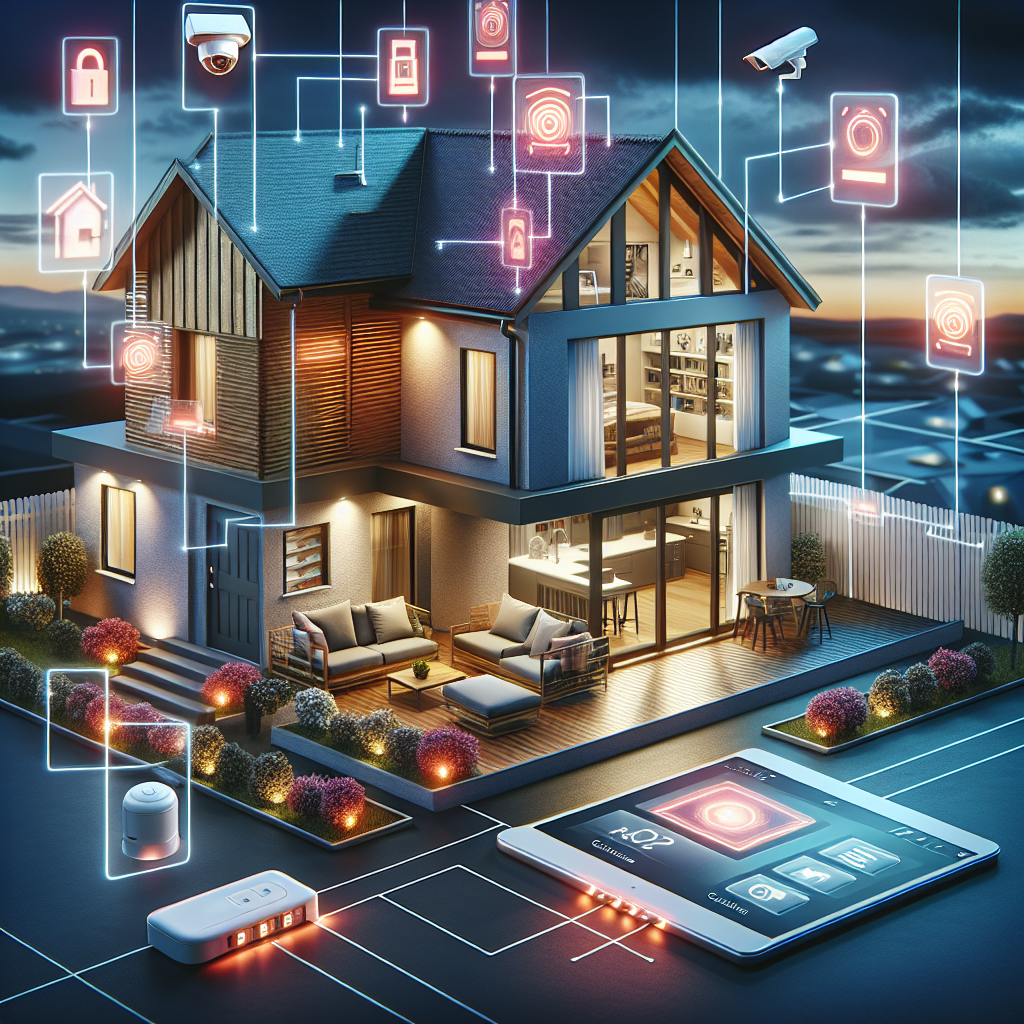Smart home integration has revolutionized the way we secure our homes, taking home security to a whole new level. By seamlessly connecting various devices and appliances, such as cameras, alarms, sensors, and smart locks, homeowners can monitor and control their security systems from anywhere in the world with just a tap on their smartphones. This enhanced level of integration not only provides real-time alerts and updates but also allows for remote access, live surveillance, and automation of security features. With smart home integration, securing your home is no longer a hassle—it’s convenient, accessible, and most importantly, effective.
Understanding Smart Home Integration and Home Security

Smart home integration refers to the process of connecting various devices and systems within a home to a central hub or network, allowing for seamless communication and control. This integration enables homeowners to remotely monitor and manage different aspects of their home, including security, lighting, heating, and entertainment systems, among others.
Importance of Home Security in Modern Times
In today’s digital age, ensuring the security of one’s home has become increasingly vital. With the rise of smart technology and interconnected devices, homeowners have more tools at their disposal to protect their properties and loved ones. Home security is no longer just about physical locks and alarms; it now encompasses a range of sophisticated solutions that leverage cutting-edge technology to provide comprehensive protection.
Overview of Smart Devices for Home Security
Smart devices for home security include a wide array of products such as smart cameras, motion sensors, doorbell cameras, smart locks, and security systems that can be controlled remotely via smartphone apps or voice commands. These devices not only enhance the overall security of a home but also offer convenience and peace of mind to homeowners, allowing them to monitor their property from anywhere at any time.
Benefits of Smart Home Integration for Home Security
Remote Monitoring Capabilities
Smart home integration offers homeowners the ability to remotely monitor their property in real-time, providing peace of mind and enhanced security. Through the use of connected cameras and sensors, individuals can access live video feeds and receive instant alerts on their smartphones or other devices. This feature allows for immediate action in the event of suspicious activity, such as unauthorized entry or unexpected motion detection. By being able to monitor their home from anywhere, homeowners can effectively deter potential intruders and quickly respond to any security threats.
Integration with Other Smart Devices
One of the key advantages of smart home integration for home security is its ability to collaborate with other smart devices within the household. By linking security systems with lighting controls, door locks, and even thermostats, homeowners can create a comprehensive and interconnected network that enhances overall security measures. For example, motion sensors can trigger lights to turn on automatically, creating the illusion of occupancy when the homeowner is away. Integrating smart locks with security systems allows for remote locking and unlocking, granting or restricting access to individuals as needed. This seamless integration not only improves convenience but also strengthens the overall security framework of the home.
Customizable Security Settings
Smart home integration empowers homeowners to customize security settings according to their specific needs and preferences. With the ability to personalize alarm configurations, notification settings, and access permissions, individuals can tailor their security system to align with their lifestyle and priorities. For instance, users can set up geofencing features that automatically arm the security system when they leave the premises and disarm it upon their return. Customizable security settings enable homeowners to adapt their security measures to changing circumstances, ensuring a dynamic and responsive approach to home protection.

Enhancing Home Security with High-Speed Internet
In the realm of smart home integration, the role of high-speed internet is paramount in enhancing home security measures. The impact of high-speed internet on smart home security cannot be overstated, as it provides a reliable connection that enables real-time monitoring of various security systems and devices. This real-time monitoring capability allows homeowners to have a constant pulse on their home’s security status, ensuring they can respond promptly to any potential threats or breaches.
Moreover, high-speed internet facilitates faster response times in case of security breaches. With instant access to live feeds from security cameras, motion sensors, and other smart devices, homeowners can quickly assess the situation and take necessary action, such as alerting authorities or activating emergency protocols. The seamless flow of data enabled by high-speed internet ensures that critical information is transmitted without delay, allowing for swift and effective responses to security incidents.
Overall, the integration of high-speed internet into smart home security systems significantly enhances the overall security posture of modern homes, providing homeowners with peace of mind and robust protection against potential threats.
Leveraging Fidium Fiber High-Speed Internet for Enhanced Security
In the realm of smart home integration for heightened security measures, the utilization of Fidium Fiber high-speed internet proves to be a pivotal component. This cutting-edge internet service offers a multitude of features that cater specifically to fortifying home security systems.
Features of Fidium Fiber internet
– Fidium Fiber internet boasts unparalleled speeds, ensuring that data transmission related to home security is swift and efficient.
– The reliability of this high-speed internet service minimizes the risk of connectivity issues, crucial for maintaining constant surveillance and monitoring capabilities.
– With low latency and high bandwidth, Fidium Fiber enables real-time communication between smart home security devices, facilitating immediate response to potential threats.
Compatibility with smart home security systems
– Fidium Fiber internet seamlessly integrates with a variety of smart home security systems, allowing for comprehensive coverage and control over the security infrastructure.
– Whether it’s CCTV cameras, motion sensors, or smart locks, Fidium Fiber supports the connectivity requirements of diverse security devices, creating a unified network for enhanced protection.
Ensuring a seamless connection for uninterrupted security measures
– The stability of Fidium Fiber internet connection plays a critical role in ensuring continuous operation of home security systems.
– By eliminating lags or disruptions in data transmission, Fidium Fiber guarantees that alerts, notifications, and emergency protocols are promptly conveyed and acted upon.

– This seamless connection provided by Fidium Fiber contributes significantly to the overall effectiveness of smart home integration in bolstering home security measures.
Challenges and Solutions in Smart Home Security Integration
Potential vulnerabilities in smart home devices
Smart home devices, ranging from smart locks to security cameras, are susceptible to security breaches due to their connection to the internet. Hackers can exploit vulnerabilities in these devices to gain unauthorized access to the home network. To mitigate this risk, manufacturers must prioritize security measures during the product development phase. This includes conducting thorough security assessments, implementing secure coding practices, and regularly releasing firmware updates to patch any identified vulnerabilities.
Importance of regular updates and maintenance
One of the key challenges in smart home security integration is the lack of awareness among users regarding the importance of regular updates and maintenance. Many users overlook the need to update their smart home devices, leaving them vulnerable to emerging threats. To address this challenge, manufacturers should educate users about the significance of software updates in enhancing the security of their smart home systems. Additionally, automated update mechanisms can be implemented to ensure that devices are regularly patched with the latest security fixes.
Implementing encryption for secure data transmission
Ensuring secure data transmission within a smart home network is crucial for protecting sensitive information from interception by unauthorized parties. Encryption plays a vital role in safeguarding data as it travels between connected devices. By implementing robust encryption protocols, such as SSL/TLS, manufacturers can ensure that data exchanged between smart home devices is encrypted and secure from potential eavesdropping attacks. Furthermore, user authentication mechanisms can be employed to verify the identity of individuals accessing the smart home network, adding an extra layer of security to the integration process.
Addressing Misconceptions About Smart Home Security
Challenges and Solutions in Smart Home Security Integration
Smart home security integration has become increasingly popular as technology advances, but it is not without its challenges. One major hurdle is the presence of misconceptions surrounding smart home security. To effectively enhance home security through smart home integration, it is crucial to address these misconceptions with clarity and accuracy.
-
Common myths about smart home security risks
- One prevalent myth is that smart home devices are easily hacked, leaving homes vulnerable to intruders. While any connected device can be a potential target for hackers, the risk can be mitigated through proper security measures such as strong passwords, regular software updates, and secure network configurations.
- Another misconception is that smart home security systems are too complex for the average homeowner to manage. However, with user-friendly interfaces and advancements in technology, smart home security systems have become more accessible and easier to use.
-
Clarifying the role of high-speed internet in security
- Some individuals believe that high-speed internet is a prerequisite for effective smart home security integration. While a stable internet connection is essential for remote monitoring and control of smart devices, many security features can function locally without a constant internet connection. Moreover, advancements in mesh networks and cellular backup options have made smart home security more reliable even in the absence of high-speed internet.
-
Educating users on best practices for secure smart home integration
- One of the key challenges in smart home security integration is the lack of awareness about best practices among users. Educating homeowners on the importance of regularly updating firmware, avoiding default passwords, and enabling multi-factor authentication can significantly enhance the security of their smart home devices.
- Additionally, promoting the use of reputable brands and products with strong security protocols can help users make informed decisions when selecting smart home devices for integration.
By dispelling misconceptions, clarifying the role of high-speed internet, and educating users on best practices, the integration of smart home technology can be leveraged to enhance home security effectively and efficiently.
Future Trends in Smart Home Security Integration
Advancements in artificial intelligence for predictive security measures
-
Utilizing machine learning algorithms: Smart home security systems are increasingly incorporating machine learning algorithms to analyze patterns and trends in data to predict potential security threats. By continuously learning from the behavior of residents and detecting anomalies, these systems can proactively identify suspicious activities and alert homeowners in real-time.
-
Predictive analytics: The integration of artificial intelligence enables smart home security systems to go beyond reactive responses to security incidents. By leveraging predictive analytics, these systems can forecast potential security risks based on historical data, weather conditions, and other relevant factors. This proactive approach helps homeowners take preventive actions to mitigate security threats before they escalate.
Integration of biometric authentication for enhanced access control
-
Biometric identification methods: Future smart home security systems are expected to incorporate biometric authentication methods such as fingerprint scanning, facial recognition, and voice recognition for enhanced access control. These biometric technologies offer a higher level of security compared to traditional password-based systems, as they are based on unique physical characteristics that are difficult to replicate or steal.
-
Multi-factor authentication: To further strengthen access control, smart home security systems may implement multi-factor authentication, combining biometric data with other factors such as passwords or security tokens. This layered approach adds an extra level of security, reducing the risk of unauthorized access to the home and its connected devices.
Potential for increased automation in home security systems
-
Automated response mechanisms: With the advancement of smart home technology, future security systems are likely to feature automated response mechanisms that can react to security threats without human intervention. For example, in the event of a break-in detected by sensors or cameras, the system can automatically alert authorities, lock doors, and activate alarms to deter intruders.
-
Integration with other smart devices: The integration of home security systems with other smart devices, such as lighting, thermostats, and smart locks, enables comprehensive automation of security measures. For instance, when the security system detects suspicious activity, it can trigger the lights to turn on, adjust the thermostat to create the appearance of occupancy, and lock all entry points to secure the premises.
Impact of 5G Technology on Smart Home Security
Future Trends in Smart Home Security Integration
The integration of 5G technology in smart home security systems is poised to revolutionize the way homeowners protect their properties. This next-generation wireless technology offers several key advantages that significantly enhance home security measures.
- Faster Data Transmission Speeds for Real-time Monitoring
5G technology provides remarkably high data transmission speeds, enabling real-time monitoring of security cameras, sensors, and other smart devices within the home. This rapid data transfer ensures that homeowners receive instant alerts and updates on any suspicious activities detected on their property, allowing for quick and informed responses to potential security threats.
- Expansion of Smart Device Connectivity with 5G Networks
With the widespread adoption of 5G networks, smart home devices can seamlessly communicate and coordinate with each other to enhance overall security measures. The increased connectivity facilitated by 5G technology enables a more integrated and comprehensive approach to home security, where different devices work in tandem to provide a layered defense system against intrusions or emergencies.
- Enhancing Overall Security Protocols with Advanced Network Capabilities
5G technology offers advanced network capabilities that can bolster the security protocols of smart home systems. By leveraging features such as network slicing and edge computing, homeowners can create personalized security configurations tailored to their specific needs. This customization not only enhances the effectiveness of security measures but also improves the overall resilience of the system against potential cyber threats or vulnerabilities.
In conclusion, the impact of 5G technology on smart home security is profound, ushering in a new era of enhanced protection and peace of mind for homeowners. By harnessing the power of 5G networks, smart home integration is set to redefine the standards of home security, making properties safer, smarter, and more secure than ever before.
FAQs: Smart Home Integration Enhanced Home Security
What is smart home integration for enhanced home security?
Smart home integration for enhanced home security refers to the use of advanced technology to connect various security devices within a home, such as cameras, sensors, and alarm systems, to a centralized control panel or mobile application. This allows homeowners to monitor and control their home security remotely, receive real-time alerts, and automate security actions.
What are some benefits of smart home integration for enhanced home security?
There are many benefits to integrating smart home technology for enhanced home security. These include increased peace of mind, as homeowners can monitor their property 24/7, receive immediate alerts in case of suspicious activity, and remotely control security devices. It also enhances convenience and flexibility, allowing for customized security settings and automation of tasks like locking doors or adjusting lighting.
What security devices can be integrated in a smart home system for enhanced home security?
A wide range of security devices can be integrated into a smart home system for enhanced security, including surveillance cameras, motion sensors, door and window sensors, smart locks, video doorbells, and alarm systems. These devices can all be connected to a central hub or smart home platform, allowing for seamless monitoring and control.
Is smart home integration for enhanced home security difficult to set up?
While setting up a smart home integration for enhanced security may require some initial installation and configuration, many systems are designed to be user-friendly and easy to set up. Most smart home security devices can be installed without professional help, and many come with step-by-step instructions or online tutorials to guide homeowners through the process.
How can smart home integration help to prevent break-ins and burglaries?
Smart home integration for enhanced security can help prevent break-ins and burglaries by providing homeowners with real-time alerts and notifications of any suspicious activity. By remotely monitoring their home and controlling security devices, homeowners can create the appearance of someone being present even when they’re away, deterring potential intruders. Additionally, smart home security systems can automatically notify authorities in case of a break-in, increasing the chances of a swift response.